There are many survival fishing kits sold on the market. Many of them are very simplistic in their content and could be helpful for the novice enthusiast. They contain some fishing hooks, a sinker (a heavy object) and some fishing line. These are the basics. It’s true you can catch some small fish, like pan fish, but would that be enough to keep hunger at bay, if you’re in a difficult survival situation?
[the_ad_placement id=”in-text-1-type-r”]Probably it won’t be enough for you. Even if you manage to catch many small fish, you will risk your gear to break. You may lose some of the hooks (it’s inevitable), or the fish line may break and you’ll be done with it.
So, in this article we will explore some of the basics and share with you which items are a-must for a survival situation. We will also share some items already compiled and sold on the web, and why they are advanced fishing kits. If you don’t want to compile your own fishing kit, you can get it done for you by purchasing such a kit. Some really great fishing kits have manuals written by enthusiasts and experienced people, so you’ll be sure to read a valuable information there.
The best survival fishing gear you can have at hand
First of all we need to talk about the fishing line. There are some very light-weight fishing lines, but they are not reliable during a survival situation. On the other hand, most commercial fishing lines are actually pretty durable.
A half a mile of cord can weigh only a quarter of a pound, which makes it extremely efficient. It’s true you can’t make such a durable and light-weight cord on your own while in the nature, so you’ll need a commercial line.
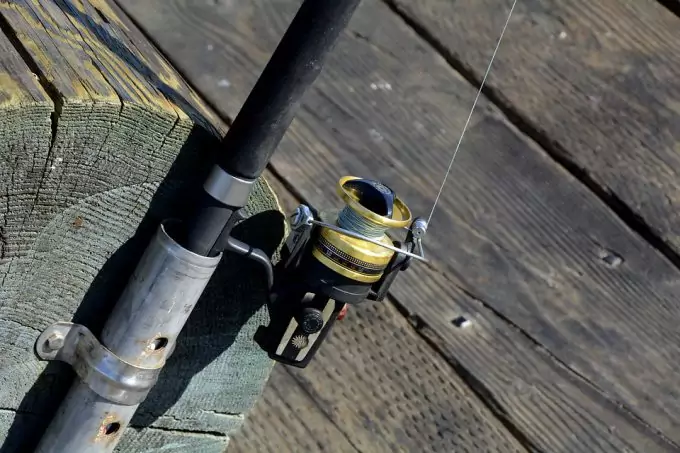
These can withstand a few pounds of weight (as you caught a fish) but this may be its limit. It will definitely break if you catch a 20-pound fish, so keep that in mind.
Of course, there are also some standards of setting some durability limit (tensile strength) that can show you how strong the fishing line is and how much it can withstand. The more the line is durable, the pricier it is, of course.
Another thing to consider is that the line will wear off if it suffers too much abrasion and cold water. So, if you want to use it in cold water (and weather) then you will need a stronger and thicker line. Of course, fish avoid such thick straight lines protruding from the surface of the water, and will have little luck catching anything.
Here comes handy if you had a fluorocarbon line, which are virtually invisible while dipped in the water (and below the surface line). Remember though, that these fluorocarbon lines aren’t as durable as some normal fishing lines are, and may not be able to withstand heavy fish. Also, you’ll need to learn how to tie the knots in order to increase the effectiveness of the fishing line. Here we have a fantastic tutorial on how to make different knots that will be of great use for a beginner anglers.
So, after taking a look at these details, you may wonder which is actually the best fishing line out there and if there is such a thing at all. Well, there is. Basically, a very sturdy and durable fishing line is the braided line. It has 3 to 5 times more strength than the normal mono filament fishing line. It’s also much stronger than the fluorocarbon line. These braided lines can withstand a whopping 50-pound weight, which is indeed impressive.
An important note on the strength of the line is that the knot seems to be the weakest spot of any fishing line. In order to improve the lines durability you can tie the hook to the line using a clinch knot. If you plan on catching much heavier than 50 pounds fish, then we advise you to carry with you two spools – one 50 and the other 100 pounds tested line.
Leaving the topic of fishing lines, we need to talk a bit about the hooks. It is true you can make your own fishing hooks from any hard material, like wire, bone, even wood. The results may be unexpected and unpredictable, so keep that in mind. Of course, commercial hooks are far better and reliable than anything hand-made. There are accessible enough so that there’s virtually no need for you to go make something like that yourself, when you can simply purchase it (and it will be much superior to any hand-made hook).
Also, consider keeping different types of hooks in your survival fishing kit. There are straight hooks and treble hooks, and both have different usage and application, which may be helpful in different situations.
Other things useful for your fishing kit are the multi-tool and a pocket knife (or even just a single-edge) so you can cut the cord (fishing line) whenever needed. It’s helpful for scale removal and cleaning the fish when you caught it. A spool of traditional nylon cord can also come in handy, especially when you already caught the fish and you need to retain it. Not to mention that you can make snares for additional food catching.
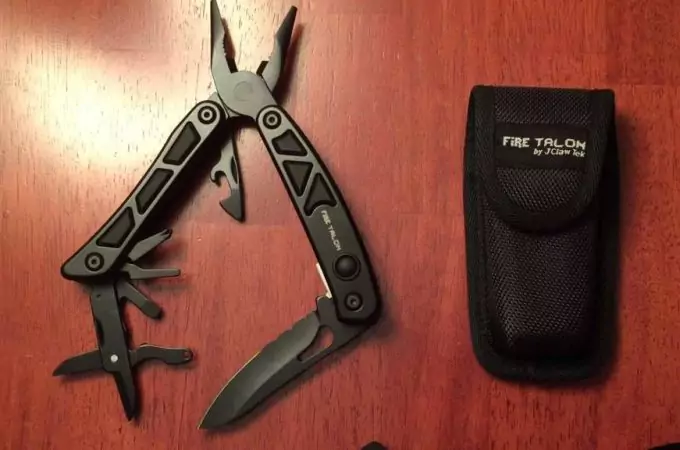
The multi-tool a great item with various purposes and uses and can come handy in almost any tricky situation. Of course, you’ll find a huge amount of multi-tools on the market or web, and this can discourage you to purchase any for the risk of buying the wrong type.
To help you with your choice, we can at least guide you to those who have these three important components: a metal file, needle-noose pliers and a knife. You can have a separate knife if you want (and it’s actually highly advisable to have a spare larger and sturdier knife). Here you can read reviews on some of the best pocket knives available today if you are interested in a purchase.
The metal file will be helpful to sharpen the edges of your hooks. They don’t stay sharp all the years you have them and dull with time. So, using the file will be great to bring them back to life.
The pliers are great for cutting the line, hooks, or other items that have caught on to something. They are also invaluable if a hook or other item gotten deformed and you need to set it right again. You can also use it to attach your sinkers to the fishing line or even try to tighten a knot. As long as you have imagination, you can use the pliers in a wide range of situations.
We also have a great set of reviews for the best multi-tools on the market with important features and prices that you must see!
[the_ad_placement id=”in-text-2-type-r”]Of course, in your fishing kit you’ll need fishing bait. Such can be worms, bugs of any type, crickets, and even small flies. Fish are attracted to any such type of insects and will bite. Of course, you should be prepared to wait for hours until you catch your first fish. You can also use small fish to attract and catch larger fish. Raw meat is also appealing to some fish, like the catfish.
If your worms or other bait has finished, you may want to consider packing salmon eggs. They are very attractive to other predatory fish. You can put them in a glass jar and use them if all your other bait has finished.
When you’ve caught your fish, tie a nylon cord around its gills through the mouth. Keep it in the water so it doesn’t escape, but remains alive.
Also remember that bread crumbs, fruit or nut pieces spread on the water surface can be a nice way to attract fish around you. This can be a setting point for the actual fishing.
Secondary importance items
A nice trick to attract fish to you may also be to use lure. This is artificial bait (which isn’t alive) and at first may seem counter-intuitive. But it still works. It bobs up and down the surface of the water mimicking frogs. You can attach some floating attributes by tying them with a rubber band and using some of the hooks you have at hand. This will add a bit more realism to your floating bait and make it look like a real creature. The type of bait usually varies according to the fish you want to catch. For instance, if you’re fishing for walleye, we have a few great examples of lures in this article.
You can also attach a slightly heavy rock to it, so it sinks to the bottom of the river. There are fish that are looking for pray only at the river bed. So if you want to maximize your catching chances, try that too.
Another artificial bait you can use are the plastic worms. And if you cover the plastic worm with smelly attractants like garlic oil or other similar, your bait will be almost life-like for other fish. It’s advisable that you do this only when you’ve run out of your live bait and you have to use the artificial bait you have.
It’s important to tug at the fishing line now and then so that your bait doesn’t look totally dead or invisible. Tugging the cord makes it move up and down the riverbed, which attracts the attention of other fish. Since you don’t know if you caught a small fish using this method you’ll have to use a retrieval method – tugging more and more until your artificial bait is at the surface. Cast it again after that and repeat this process until you actually caught something. Do it slowly, otherwise sharp and jerky movements may look aggressive and fish won’t approach your lure.
During the retrieval process, when your bait has already reached the surface of the water, be careful and let it remain on the surface for a while (a few minutes) and notice if there is some unnatural movement of the line. If so, then there’s a high chance that you actually have caught a fish. So, now is the moment to tug a bit sharper and harder so that the hook gets set in place.
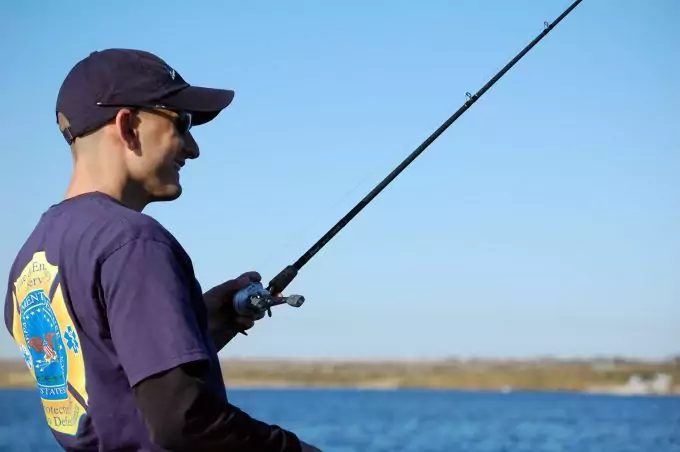
Another interesting lure you can make is using a simple metal bottle cap. This is a very easy method and works even in streams and currents. Take the bottle cap and try to fold it in two by pressing it inside (so that the printed label remains on top). It will look like a body of a fish (without the fins).
Set holes at the two sharp ends (the ‘head’ and ‘tail’ areas of your artificial fish) and attach one end to a hook and the other to the fishing line itself. In this way it will remain upright and will appear as if it’s swimming. This is especially true if, as we mentioned, you’re fishing in a stream.
If you want to catch more fish, this may mean to set more bait and use more fishing lines and hooks. That’s why having at least 40 hooks in your fishing kit is not only wise it’s a must. As we said earlier, have several spools, so you can attach multiple fishing lines to some nearby trees of branches. Attach hooks at equal distance and place the end of the cord in the water. You will end up with a straight line with hooks attached to it. And while you do something else, fish will get attracted to the bait and you will have fish within less than 30 minutes without having done anything extraordinary.
Provided you’re out of the live bait, and your artificial bait doesn’t work (or you didn’t pack it), you can use what the land around you provides. Dig around for some worms, centipedes, and other insects and use them. Another good idea is to use leeches or minnows. Attach the hook to them (they have to be alive) and let them in the water. Their swimming motion will immediately attract some nearby fish.
After all we said about lines, bait and hooks, we have to move on to other tools of secondary importance. This doesn’t mean they can be easily omitted, but more like – you can’t catch fish without a fishing line or a hook, but you can catch it without secondary tools.
One such handy tool is the sinker. It’s an object with some slight weight added to it – hence the name, sinker. It gives a bit of tension to your fishing line and will drag it a bit towards the bottom of the river (or lake). In fact a lot of fish prefer to swim in middle waters or stay at riverbed level. If a fish goes to the surface it’s because they just sunbathe. So, not to miss your prey, use a sinker and you’ll surely have raised changes of catching fish.
Also, you’ll need a metal container with an easy to remove lid, but still keeps all your gear in one place. You can even keep in it your live bait. Other useful tools can be paper clips, rubber bands, safety pins, etc. You never know when these small and seemingly insignificant tools can actually come in handy.
So, what would be the best metal container? Usually this is the Altoids. These small and compact containers are great and used by many survivalists – from hikers keeping valuable first-aid kit items, to survivalists prepared to live off fish. Altoids have many purposes. In this case, they will safely contain your items and gear.
[the_ad_placement id=”in-text-3-type-r”]The reason why it’s a great option is that it’s small and you can be sure that your items stay together and organized. After all your tools are often very small and it can be tricky if they get lost somewhere. Even if you prefer to use a plastic bag, this may not be the safest way, since plastic bags can get ripped by sharp objects, and your items can get spilled out.
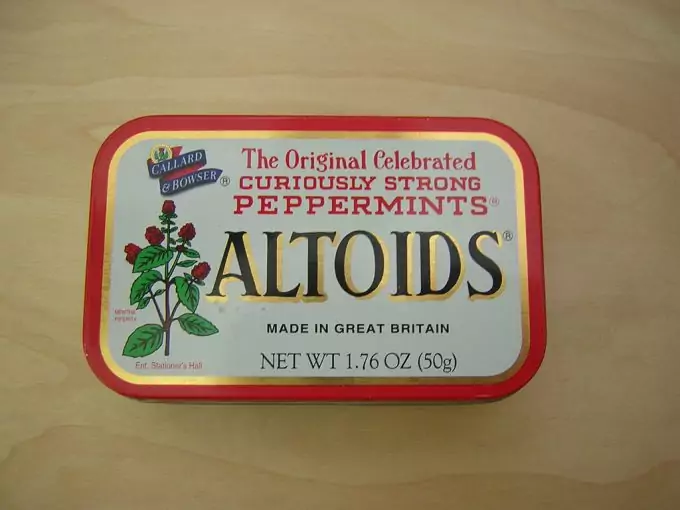
On the other hand, you can sort your items and set them in small plastic bags (with zipper) and then place all bags in the Altoids. This will keep them from mixing together too much and getting tangled up.
Up to now you may be thinking it’s too much of a hassle to make your own survival fishing kit. What would be great now is if you can just get it done by someone else.
Finally we can advise you, if you have never gone fishing before, to first try that in safe testing conditions. Don’t leave that valuable training for the survival situation you may get into in the future. If you’re hiking or camping often but don’t have experience fishing, then now is the time. Next time you go camping, try the above items and advice and see how things go.
You may have to learn a lot of tricks and tactics, from how not to spook the fish to some more advanced tactics like climbing a tree and fishing from a tree branch. And remember, practice makes perfect. Don’t despair if you can’t catch fish from the first several times. Try as many times as you can and practice with an experienced fisher. Next time when you’re in a critical survival situation you will have more experience and will be able to prepare your own meal.



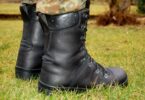

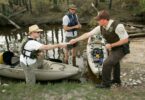
A year ago I made a survival fishing unit; my friends enjoyed making use of it, so I made some more to give to them and sell. This is the content:
– Five #8 fishing hooks
– 5 sinkers
– Knot Guide with directions
– 60′ 15lb nylon thread
– 30′ 12lb big game Trilene fishing line
– 11 gulp maggots
– Jumbo test tube which acts as a storage tube and reel
– Four spinner lures
I regularly use this kit to catch catfish, bass, and pike in lakes.
Hey Wayne,
This is a great list of items to put in a fishing kit but do not forget to add some bobs, a needle nose plier and line cutters. These will help you enjoy the fishing experience more and lets you be prepared when SHTF.
Regards,
Andrew
I’ve been fishing for years now and I wish I could have encountered this one. Stocking my stuff inside small individual plastic bags would have saved me a lot of trouble and time from sorting out, especially the much smaller tools. I’m just wondering why the highlight of using Altoids? Can I use any other metal container or does this have a special chemical component that can withstand better impact maybe or higher resistance to corrosion?
Altoids kit is a great option because it is small and you can be sure that your items stay together and organized.